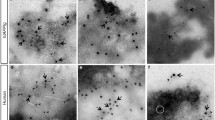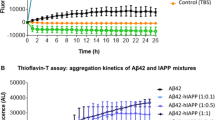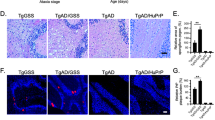Abstract
Numerous epidemiological studies have shown a significantly higher risk for development of Alzheimer’s disease (AD) in patients affected by type 2 diabetes (T2D), but the molecular mechanism responsible for this association is presently unknown. Both diseases are considered protein misfolding disorders associated with the accumulation of protein aggregates; amyloid-beta (Aβ) and tau in the brain during AD, and islet amyloid polypeptide (IAPP) in pancreatic islets in T2D. Formation and accumulation of these proteins follows a seeding-nucleation model, where a misfolded aggregate or ‘seed’ promotes the rapid misfolding and aggregation of the native protein. Our underlying hypothesis is that misfolded IAPP produced in T2D potentiates AD pathology by cross-seeding Aβ, providing a molecular explanation for the link between these diseases. Here, we examined how misfolded IAPP affects Aβ aggregation and AD pathology in vitro and in vivo. We observed that addition of IAPP seeds accelerates Aβ aggregation in vitro in a seeding-like manner and the resulting fibrils are composed of both peptides. Transgenic animals expressing both human proteins exhibited exacerbated AD-like pathology compared with AD transgenic mice or AD transgenic animals with type 1 diabetes (T1D). Remarkably, IAPP colocalized with amyloid plaques in brain parenchymal deposits, suggesting that these peptides may directly interact and aggravate the disease. Furthermore, inoculation of pancreatic IAPP aggregates into the brains of AD transgenic mice resulted in more severe AD pathology and significantly greater memory impairments than untreated animals. These data provide a proof-of-concept for a new disease mechanism involving the interaction of misfolded proteins through cross-seeding events which may contribute to accelerate or exacerbate disease pathogenesis. Our findings could shed light on understanding the linkage between T2D and AD, two of the most prevalent protein misfolding disorders.
This is a preview of subscription content, access via your institution
Access options
Subscribe to this journal
Receive 12 print issues and online access
$259.00 per year
only $21.58 per issue
Buy this article
- Purchase on Springer Link
- Instant access to full article PDF
Prices may be subject to local taxes which are calculated during checkout




Similar content being viewed by others
References
Chiti F, Dobson CM . Protein misfolding, functional amyloid, and human disease. Annu Rev Biochem 2006; 75: 333–366.
Soto C . Unfolding the role of protein misfolding in neurodegenerative diseases. Nat Rev Neurosci 2003; 4: 49–60.
Clinton LK, Blurton-Jones M, Myczek K, Trojanowski JQ, LaFerla FM . Synergistic Interactions between Abeta, tau, and alpha-synuclein: acceleration of neuropathology and cognitive decline. J Neurosci 2010; 30: 7281–7289.
Giasson BI, Lee VM, Trojanowski JQ . Interactions of amyloidogenic proteins. Neuromolecular Med 2003; 4: 49–58.
Walker L, McAleese KE, Thomas AJ, Johnson M, Martin-Ruiz C, Parker C et al. Neuropathologically mixed Alzheimer's and Lewy body disease: burden of pathological protein aggregates differs between clinical phenotypes. Acta Neuropathol 2015; 129: 729–748.
Kovacs GG, Alafuzoff I, Al-Sarraj S, Arzberger T, Bogdanovic N, Capellari S et al. Mixed brain pathologies in dementia: the BrainNet Europe consortium experience. Dement Geriatr Cogn Disord 2008; 26: 343–350.
Barker WW, Luis CA, Kashuba A, Luis M, Harwood DG, Loewenstein D et al. Relative frequencies of Alzheimer disease, Lewy body, vascular and frontotemporal dementia, and hippocampal sclerosis in the State of Florida Brain Bank. Alzheimer Dis Assoc Disord 2002; 16: 203–212.
Guerrero-Munoz MJ, Castillo-Carranza DL, Krishnamurthy S, Paulucci-Holthauzen AA, Sengupta U, Lasagna-Reeves CA et al. Amyloid-beta oligomers as a template for secondary amyloidosis in Alzheimer's disease. Neurobiol Dis 2014; 71: 14–23.
Jackson K, Barisone GA, Diaz E, Jin LW, Decarli C, Despa F . Amylin deposition in the brain: A second amyloid in Alzheimer disease? Ann Neurol 2013; 74: 517–526.
Miklossy J, Qing H, Radenovic A, Kis A, Vileno B, Laszlo F et al. Beta amyloid and hyperphosphorylated tau deposits in the pancreas in type 2 diabetes. Neurobiol Aging 2010; 31: 1503–1515.
Biessels GJ, Staekenborg S, Brunner E, Brayne C, Scheltens P . Risk of dementia in diabetes mellitus: a systematic review. Lancet Neurol 2006; 5: 64–74.
Luchsinger JA, Reitz C, Patel B, Tang MX, Manly JJ, Mayeux R . Relation of diabetes to mild cognitive impairment. Arch Neurol 2007; 64: 570–575.
Kopf D, Frolich L . Risk of incident Alzheimer's disease in diabetic patients: a systematic review of prospective trials. J Alzheimers Dis 2009; 16: 677–685.
Ott A, Stolk RP, van Harskamp F, Pols HA, Hofman A, Breteler MM . Diabetes mellitus and the risk of dementia: The Rotterdam Study. Neurology 1999; 53: 1937–1942.
Velayudhan L, Poppe M, Archer N, Proitsi P, Brown RG, Lovestone S . Risk of developing dementia in people with diabetes and mild cognitive impairment. Br J Psychiatry 2010; 196: 36–40.
Morris JK, Vidoni ED, Honea RA, Burns JM . Impaired glycemia increases disease progression in mild cognitive impairment. Neurobiol Aging 2014; 35: 585–589.
Janson J, Laedtke T, Parisi JE, O'Brien P, Petersen RC, Butler PC . Increased risk of type 2 diabetes in Alzheimer disease. Diabetes 2004; 53: 474–481.
Qiu WQ, Wallack M, Dean M, Liebson E, Mwamburi M, Zhu H . Association between amylin and amyloid-beta peptides in plasma in the context of apolipoprotein E4 allele. PLoS One 2014; 9: e88063.
Biessels GJ, Kappelle LJ . Increased risk of Alzheimer's disease in type II diabetes: insulin resistance of the brain or insulin-induced amyloid pathology? Biochem Soc Trans 2005; 33: 1041–1044.
Jarrett JT, Lansbury PT Jr. . Seeding "one-dimensional crystallization" of amyloid: a pathogenic mechanism in Alzheimer's disease and scrapie? Cell 1993; 73: 1055–1058.
Soto C, Estrada L, Castilla J . Amyloids, prions and the inherent infectious nature of misfolded protein aggregates. Trends Biochem Sci 2006; 31: 150–155.
Morales R, Moreno-Gonzalez I, Soto C . Cross-seeding of misfolded proteins: implications for etiology and pathogenesis of protein misfolding diseases. PLoS Pathog 2013; 9: e1003537.
Yan J, Fu X, Ge F, Zhang B, Yao J, Zhang H et al. Cross-seeding and cross-competition in mouse apolipoprotein A-II amyloid fibrils and protein A amyloid fibrils. Am J Pathol 2007; 171: 172–180.
Vitrenko YA, Gracheva EO, Richmond JE, Liebman SW . Visualization of aggregation of the Rnq1 prion domain and cross-seeding interactions with Sup35NM. J Biol Chem 2007; 282: 1779–1787.
Krebs MR, Morozova-Roche LA, Daniel K, Robinson CV, Dobson CM . Observation of sequence specificity in the seeding of protein amyloid fibrils. Protein Sci 2004; 13: 1933–1938.
O'Nuallain B, Williams AD, Westermark P, Wetzel R . Seeding specificity in amyloid growth induced by heterologous fibrils. J Biol Chem 2004; 279: 17490–17499.
Ono K, Takahashi R, Ikeda T, Mizuguchi M, Hamaguchi T, Yamada M . Exogenous amyloidogenic proteins function as seeds in amyloid beta-protein aggregation. Biochim Biophys Acta 2014; 1842: 646–653.
Andreetto E, Yan LM, Tatarek-Nossol M, Velkova A, Frank R, Kapurniotu A . Identification of hot regions of the Abeta-IAPP interaction interface as high-affinity binding sites in both cross- and self-association. Angew Chem Int Ed Engl 2010; 49: 3081–3085.
Shahnawaz M, Soto C . Microcin amyloid fibrils are a reservoir of toxic oligomeric species. J Biol Chem 2012; 287: 11665–11676.
Hsiao K, Chapman P, Nilsen S, Eckman C, Harigaya Y, Younkin S et al. Correlative memory deficits, Abeta elevation, and amyloid plaques in transgenic mice. Science 1996; 274: 99–102.
Janson J, Soeller WC, Roche PC, Nelson RT, Torchia AJ, Kreutter DK et al. Spontaneous diabetes mellitus in transgenic mice expressing human islet amyloid polypeptide. Proc Natl Acad Sci USA 1996; 93: 7283–7288.
Tesch GH, Allen TJ . Rodent models of streptozotocin-induced diabetic nephropathy. Nephrology (Carlton) 2007; 12: 261–266.
Luchsinger JA . Type 2 diabetes and cognitive impairment: linking mechanisms. J Alzheimers Dis 2012; 30: S185–S198.
Yamamoto N, Matsubara T, Sobue K, Tanida M, Kasahara R, Naruse K et al. Brain insulin resistance accelerates Abeta fibrillogenesis by inducing GM1 ganglioside clustering in the presynaptic membranes. J Neurochem 2012; 121: 619–628.
Bourdel-Marchasson I, Lapre E, Laksir H, Puget E . Insulin resistance, diabetes and cognitive function: consequences for preventative strategies. Diabetes Metab 2010; 36: 173–181.
Reger MA, Watson GS, Green PS, Wilkinson CW, Baker LD, Cholerton B et al. Intranasal insulin improves cognition and modulates beta-amyloid in early AD. Neurology 2008; 70: 440–448.
Haj-ali V, Mohaddes G, Babri SH . Intracerebroventricular insulin improves spatial learning and memory in male Wistar rats. Behav Neurosci 2009; 123: 1309–1314.
Kim B, Backus C, Oh S, Hayes JM, Feldman EL . Increased tau phosphorylation and cleavage in mouse models of type 1 and type 2 diabetes. Endocrinology 2009; 150: 5294–5301.
Ke YD, Delerue F, Gladbach A, Gotz J, Ittner LM . Experimental diabetes mellitus exacerbates tau pathology in a transgenic mouse model of Alzheimer's disease. PLoS One 2009; 4: e7917.
Escribano L, Simon AM, Gimeno E, Cuadrado-Tejedor M, Lopez de MR, Garcia-Osta A et al. Rosiglitazone rescues memory impairment in Alzheimer's transgenic mice: mechanisms involving a reduced amyloid and tau pathology. Neuropsychopharmacology 2010; 35: 1593–1604.
McClean PL, Parthsarathy V, Faivre E, Holscher C . The diabetes drug liraglutide prevents degenerative processes in a mouse model of Alzheimer's disease. J Neurosci 2011; 31: 6587–6594.
Watson GS, Cholerton BA, Reger MA, Baker LD, Plymate SR, Asthana S et al. Preserved cognition in patients with early Alzheimer disease and amnestic mild cognitive impairment during treatment with rosiglitazone: a preliminary study. Am J Geriatr Psychiatry 2005; 13: 950–958.
Risner ME, Saunders AM, Altman JF, Ormandy GC, Craft S, Foley IM et al. Efficacy of rosiglitazone in a genetically defined population with mild-to-moderate Alzheimer's disease. Pharmacogenomics J 2006; 6: 246–254.
Hanyu H, Sato T, Kiuchi A, Sakurai H, Iwamoto T . Pioglitazone improved cognition in a pilot study on patients with Alzheimer's disease and mild cognitive impairment with diabetes mellitus. J Am Geriatr Soc 2009; 57: 177–179.
Oskarsson ME, Paulsson JF, Schultz SW, Ingelsson M, Westermark P, Westermark GT . In vivo seeding and cross-seeding of localized amyloidosis: a molecular link between type 2 diabetes and Alzheimer disease. Am J Pathol 2015; 185: 834–846.
Janson J, Ashley RH, Harrison D, McIntyre S, Butler PC . The mechanism of islet amyloid polypeptide toxicity is membrane disruption by intermediate-sized toxic amyloid particles. Diabetes 1999; 48: 491–498.
Lambert MP, Barlow AK, Chromy BA, Edwards C, Freed R, Liosatos M et al. Diffusible, nonfibrillar ligands derived from Abeta1-42 are potent central nervous system neurotoxins. Proc Natl Acad Sci USA 1998; 95: 6448–6453.
Srodulski S, Sharma S, Bachstetter AB, Brelsfoard JM, Pascual C, Xie XS et al. Neuroinflammation and neurologic deficits in diabetes linked to brain accumulation of amylin. Mol Neurodegener 2014; 9: 30.
Okabayashi S, Shimozawa N, Yasutomi Y, Yanagisawa K, Kimura N . Diabetes mellitus accelerates Abeta pathology in brain accompanied by enhanced GAbeta generation in nonhuman primates. PLoS One 2015; 10: e0117362.
Gotz J, Ittner LM, Lim YA . Common features between diabetes mellitus and Alzheimer's disease. Cell Mol Life Sci 2009; 66: 1321–1325.
Jolivalt CG, Hurford R, Lee CA, Dumaop W, Rockenstein E, Masliah E . Type 1 diabetes exaggerates features of Alzheimer's disease in APP transgenic mice. Exp Neurol 2010; 223: 422–431.
Acknowledgements
We thank Dr Peter C Butler (University of California at Los Angeles) for the donation of the IAPP diabetic colony and Dr Charles Mays (University of Texas Medical School at Houston) for extensive editing of the manuscript. This work was partially funded by NIH grant R01GM100453 to CS.
Author information
Authors and Affiliations
Corresponding author
Ethics declarations
Competing interests
The authors declare no conflict of interest.
Additional information
Supplementary Information accompanies the paper on the Molecular Psychiatry website
Supplementary information
Rights and permissions
About this article
Cite this article
Moreno-Gonzalez, I., Edwards III, G., Salvadores, N. et al. Molecular interaction between type 2 diabetes and Alzheimer’s disease through cross-seeding of protein misfolding. Mol Psychiatry 22, 1327–1334 (2017). https://doi.org/10.1038/mp.2016.230
Received:
Revised:
Accepted:
Published:
Issue Date:
DOI: https://doi.org/10.1038/mp.2016.230



